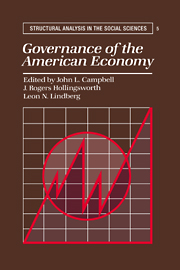Book contents
- Frontmatter
- Contents
- List of figures
- List of tables
- List of contributors
- Preface
- I Conceptual and historical foundations
- II Empirical studies of governance transformations in the United States
- III Theoretical evaluation of the empirical cases
- 11 The evolution of governance regimes
- 12 The state and the organization of economic activity
- References
- Index
12 - The state and the organization of economic activity
Published online by Cambridge University Press: 21 March 2010
- Frontmatter
- Contents
- List of figures
- List of tables
- List of contributors
- Preface
- I Conceptual and historical foundations
- II Empirical studies of governance transformations in the United States
- III Theoretical evaluation of the empirical cases
- 11 The evolution of governance regimes
- 12 The state and the organization of economic activity
- References
- Index
Summary
The analytic framework introduced in the previous chapter depicts governance regimes and governance transformations as the products of the strategic actions and institutional structures of private actors and the state. This conception of how the state helps to constitute sectors in a national economy differs sharply from the conventional literature on state-economy relations. Economists and non-economists alike typically take the structure of the economy and the direction of economic development as given. In this view, states may help clear the way for accumulation, and distort, retard, or accelerate the accumulation process. But states do not decisively influence the forms of economic organization and coordination of economic activities. States may be more or less autonomous, and states may be weak or strong. But they are rarely seen as transformative in this sense (Weiss 1988). Even institutional political economists who have produced so much valuable theory and research on the causes of variations in the forms and effectiveness of state intervention have not come up with good predictions of the forms of capitalism that are likely to be promoted by state intervention (Weiss 1988).
The problem lies in the conception of state intervention into the economy and the focus of state literature on different types of intervention. The very notion of intervention perpetuates the imagery of a clear separation of state and economy where markets, for example, can, or at least did, once upon a time, exist in a truly laissez-faire condition, completely autonomous of the state's influence.
- Type
- Chapter
- Information
- Governance of the American Economy , pp. 356 - 395Publisher: Cambridge University PressPrint publication year: 1991
- 24
- Cited by

